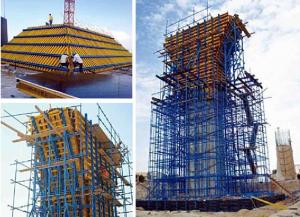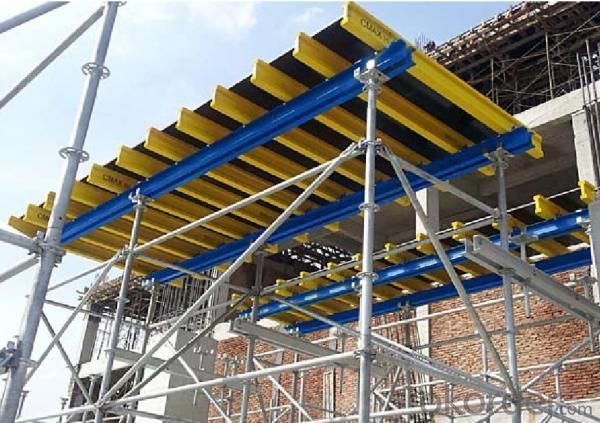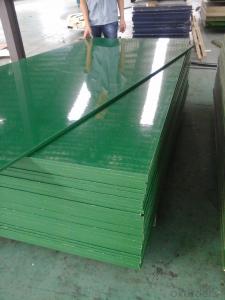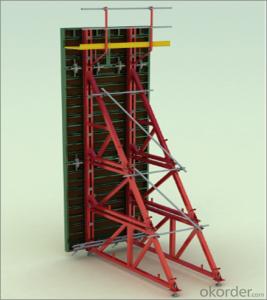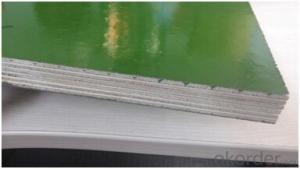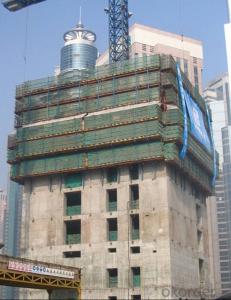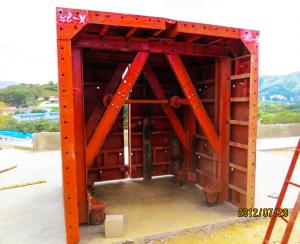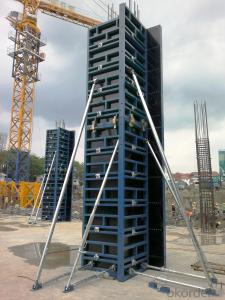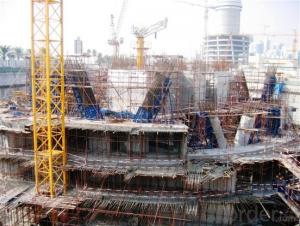Steel-frame Formwork
- Loading Port:
- XINGANG
- Payment Terms:
- TT or LC
- Min Order Qty:
- 55 Cubic Meter/Cubic Meters m.t.
- Supply Capability:
- 5000 Cubic Meter/Cubic Meters per Month m.t./month
OKorder Service Pledge
OKorder Financial Service
You Might Also Like
Quick Details of Steel-frame Formwork
Type: Plywoods
Place of Origin: China (Mainland)
Brand Name: CMAX
Usage: Outdoor
Grade: First-Class
Main Material: Poplar
Formaldehyde Emission Standards: E1
Plywood Type: 13-Ply Boards
Film: black,brown,red,anti-slip
Core: poplar,hardwood,eucalyptus,combi,birch
Glue: melamine WBP,phenolic
WBP Size: 1220*2440mm,1250*2500mm
Thickness: 9mm,12mm,15mm,18mm,21mm
Pressing: 1 time,2 times
Packaging & Delivery Steel-frame Formwork
Packaging Detail: inner with plastic bag,outer with carton board or thin plywood then fastened by steel belts with pallet
Delivery Detail: Within 15 days after receiving deposit or original L/C at sight
Specifications Steel-frame Formwork
1)Film:brown,black,red,anti-slip
2)Core:poplar,hardwood,combi,birch
3)Glue:melamine WBP,phenolic WBP
4)Useage:construction
Item | Film faced plywood/Marine plywood/Construction plywood | |
Face/Back | Brown film,Black Film,Red film,Anti-slip film | |
Core | Poplar,hardwood,Eucalyptus, Poplar, Birch | |
Glue | Melamine WBP glue,Phenolic WBP glue | |
Size(mm) | 1220×2440mm,1250×2500mm or as request | |
Thickness(mm) | 9mm,12mm,15mm,18mm,21mm | |
Moisture | 6-12% | |
Thickness tolerance | +/-0.5mm
| |
Packing | inner with plastic bag,outer with carton board or thin plywood then fastened by 4×6 lines steel belts with pallet | |
Quantity | 20’GP | 8 plts/22M3 |
40’GP | 16 plts/48M3 | |
40’HQ | 18 plts/55M3 | |
Useage | Using for making construction, industry | |
MOQ | 1×40'HQ | |
Payment Terms | TT:30% deposit, the balance agaist B/L copy L/C: irrevocable L/C at sight | |
Delievery Time | Within 15 days after receiving 30% deposit or original L/C at sight | |
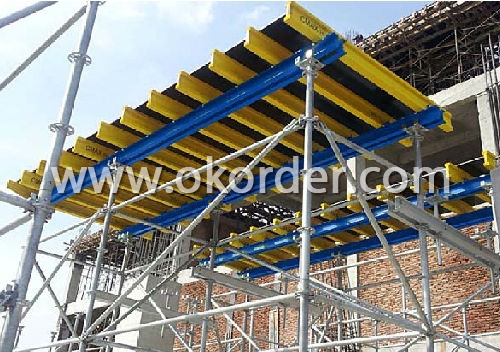

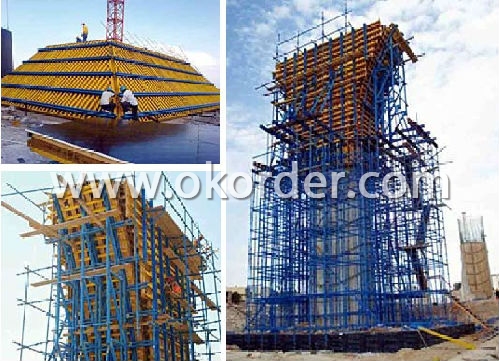
- Q: Can steel frame formwork be used for bridge construction?
- Indeed, bridge construction can make use of steel frame formwork. This system, known for its versatility and durability, provides the necessary support and structure for concrete formations, including bridges. Engineers can benefit from its flexibility in design, allowing them to create intricate shapes and sizes for various bridge components like piers, abutments, and beams. Moreover, the steel frame formwork system can withstand the immense loads and pressures involved in bridge construction, making it an ideal choice for such projects. Furthermore, this system facilitates quicker construction due to its easy assembly, disassembly, and potential for reuse in multiple endeavors.
- Q: Does steel frame formwork require any specific surface preparation?
- Yes, steel frame formwork generally requires surface preparation before use. This involves removing any dirt, rust, or debris from the surface of the steel frame to ensure proper adhesion and prevent any potential issues during the concrete pouring process.
- Q: How does steel frame formwork handle concrete curing in hot conditions?
- Confronted with scorching temperatures, the steel frame formwork proves its mettle by facilitating the concrete's curing process with unwavering stability and robustness. Purposefully engineered, these steel frames bear the brunt of the concrete's weight while providing essential support during curing. Within hot environmental conditions, the steel frame formwork acts as a temperature regulator for the concrete, offering insulation that mitigates rapid drying and guarantees a more controlled curing process. Moreover, these steel frames function as safeguarding agents, minimizing the likelihood of cracking or shrinkage attributable to the heat. Moreover, the steel frame formwork allows for adequate ventilation and air circulation around the concrete, effectively dissipating any excessive heat and averting overheating. This aspect is of paramount importance, as excessive heat poses a risk of thermal cracking and compromises the structural integrity. Adding to its merits, the steel frame formwork exhibits exceptional durability, withstanding the expansion and contraction that naturally ensues during the curing process in hot conditions. This unwavering resilience ensures the structure remains unwavering and secure. In conclusion, the steel frame formwork presents itself as a dependable and efficient solution when faced with the challenge of concrete curing in hot weather. It furnishes the essential elements of support, insulation, and ventilation, guaranteeing a successful and enduring curing process.
- Q: What are the safety precautions for using steel frame formwork in hazardous conditions?
- When using steel frame formwork in hazardous conditions, it is crucial to take certain safety precautions to ensure the well-being of workers. Here are some safety measures that should be followed: 1. Training and awareness: Workers should receive thorough training on the proper use of steel frame formwork in hazardous conditions. They should be educated about potential risks, such as falls, cuts, and strains, and how to mitigate these risks. 2. Personal protective equipment (PPE): All workers should wear appropriate PPE, including helmets, safety boots, gloves, and protective clothing. Safety glasses or goggles should be worn to protect the eyes from dust, debris, and other hazardous materials. 3. Inspection and maintenance: Regular inspection of the steel frame formwork should be conducted to identify any damage or defects that could compromise its integrity. Any issues should be addressed immediately, and damaged or worn-out components should be replaced. 4. Secure and stable setup: The steel frame formwork should be properly secured and stabilized to prevent accidental collapses. Adequate bracing and support systems should be in place, and the formwork should be securely anchored to the ground or supporting structure. 5. Fall protection: Workers should use fall protection equipment, such as harnesses, lanyards, and anchor points, when working at heights. Guardrails or safety nets should be installed to prevent falls from elevated platforms. 6. Proper lifting techniques: Workers should be trained in proper lifting techniques and should avoid overexertion. Mechanical lifting aids, such as cranes or hoists, should be used whenever possible to reduce the risk of strains or injuries. 7. Hazardous material handling: If hazardous materials are being used in conjunction with the steel frame formwork, proper handling procedures should be followed. Workers should be trained on the safe handling and storage of these materials, and any necessary precautions, such as ventilation or personal protective equipment, should be implemented. 8. Emergency preparedness: Adequate emergency plans should be in place, including evacuation procedures, first aid training, and access to emergency contact information. All workers should be familiar with these procedures and know how to respond in case of an emergency. By following these safety precautions, the use of steel frame formwork in hazardous conditions can be carried out with minimized risks and enhanced worker safety.
- Q: What are the safety measures that need to be taken while using steel frame formwork?
- Some of the safety measures that need to be taken while using steel frame formwork include wearing appropriate personal protective equipment (PPE) such as safety helmets, gloves, and safety boots. It is important to ensure that the formwork is inspected regularly for any defects or damage before use. Workers should receive proper training on the correct assembly and dismantling procedures to prevent accidents. Adequate bracing and support should be provided to ensure stability and prevent collapse. Additionally, following proper handling techniques and using appropriate lifting equipment can help prevent injuries.
- Q: What are the considerations for selecting the appropriate formwork for different concrete finishes?
- Several factors need to be taken into account when choosing the right formwork for different concrete finishes. Firstly, it is important to clearly define the desired concrete finish. There are several options available, including smooth, textured, exposed aggregate, or architectural finishes. Each of these finishes requires specific formwork to achieve the desired result. For instance, smooth finishes may require high-quality plywood or steel panels for a seamless appearance, while textured finishes may necessitate form liners or specialized textured panels. Secondly, the complexity of the formwork design should be considered. If the concrete finish requires intricate patterns or unique shapes, the formwork should be flexible enough to accommodate these design elements. This may involve using adjustable formwork systems or custom-made formwork. The durability of the formwork is another crucial factor to consider. Concrete exerts significant pressure on the formwork during pouring and curing, so it must be strong enough to withstand these forces. Additionally, the formwork should be resistant to moisture and chemicals present in the concrete mix. Opting for formwork made from materials like steel or high-quality plywood ensures durability and longevity. Ease of assembly and disassembly is also worth considering. Efficient formwork systems that are quick and easy to install and dismantle can save time and labor costs. Some formwork systems come with interlocking components or adjustable features, making them quicker and easier to work with. Cost is an important consideration when selecting formwork. The formwork should provide value for money while meeting the desired finish requirements. Comparing the costs of different formwork options, including rental and purchase options, can help determine the most cost-effective solution. Lastly, safety considerations should never be overlooked. The formwork should be designed and installed in a way that ensures the safety of workers during the construction process. This may involve using formwork with built-in safety features or incorporating additional safety measures, such as guardrails or working platforms. In conclusion, selecting the appropriate formwork for different concrete finishes requires careful consideration of factors such as the desired finish, complexity of the design, durability, ease of assembly, cost, and safety. By taking these factors into account, one can choose the most suitable formwork system to efficiently and effectively achieve the desired concrete finish.
- Q: Can steel frame formwork be used for circular columns?
- Yes, steel frame formwork can be used for circular columns. It is flexible and adjustable, allowing it to be easily adapted to the desired shape and size of circular columns.
- Q: How does steel frame formwork handle architectural features such as openings and recesses?
- Steel frame formwork is highly versatile and can easily handle architectural features such as openings and recesses. It allows for customization and precision in design, enabling the creation of various shapes and sizes. The steel frames can be easily adjusted, modified, or removed to accommodate specific architectural features, ensuring a seamless integration of openings and recesses within the overall structure.
- Q: Can steel frame formwork be used for the construction of healthcare facilities?
- Yes, steel frame formwork can be used for the construction of healthcare facilities. Steel frame formwork is a versatile and durable construction technique that is commonly used in various building projects, including healthcare facilities. This formwork system consists of steel frames, which are designed to support the weight of the concrete and other construction materials during the pouring and curing process. There are several advantages to using steel frame formwork in the construction of healthcare facilities. Firstly, steel is a strong and rigid material that can withstand heavy loads, making it suitable for large-scale construction projects. Secondly, steel formwork is highly durable and can be used multiple times, reducing the overall construction costs. Additionally, steel frame formwork provides a smooth and even surface finish, which is essential for the construction of healthcare facilities that require sanitary and hygienic conditions. Moreover, steel frame formwork allows for efficient construction processes, as it is easy to assemble and disassemble. This saves time and labor costs during the construction phase. Additionally, the flexibility of steel formwork allows for customization and adaptability to meet specific design requirements of healthcare facilities. It is important to note that the use of steel frame formwork for healthcare facilities should comply with the relevant building codes and regulations. Proper engineering and design considerations must be taken into account to ensure the structural integrity and safety of the building. In conclusion, steel frame formwork is a suitable construction method for healthcare facilities. Its strength, durability, and flexibility make it an ideal choice for constructing buildings that require high standards of hygiene and functionality.
- Q: Does steel frame formwork require any specific lifting or hoisting equipment?
- The installation and removal of steel frame formwork typically necessitate the use of specific lifting or hoisting equipment. Given the considerable weight and size of steel frames, it becomes imperative to utilize specialized machinery like cranes or forklifts to hoist and position the formwork appropriately. These lifting apparatuses ensure the secure and efficient handling of the steel frames, enabling accurate alignment and securement for concrete pouring. Similarly, during the dismantling process, hoisting equipment is employed to eliminate the formwork without causing any harm or injury. In conclusion, the utilization of specific lifting or hoisting equipment is crucial for the correct installation and removal of steel frame formwork.
1. Manufacturer Overview
| Location | Beijing, China |
| Year Established | 1995 |
| Annual Output Value | US$ 5 Million - US$ 6 Million |
| Main Markets | China; United States; Britain; Japan; Germany; Israel |
| Company Certifications | ISO 9001:2000;GBT 19001:2000 |
2. Manufacturer Certificates
| a) Certification Name | |
| Range | |
| Reference | |
| Validity Period |
3. Manufacturer Capability
| a) Trade Capacity | |
| Nearest Port | Xingnang |
| Export Percentage | |
| No.of Employees in Trade Department | 5 to 10 |
| Language Spoken: | Chinese; English |
| b) Factory Information | |
| Factory Size: | Above 6600 square meters |
| No. of Production Lines | Above 10 |
| Contract Manufacturing | Design Service Offered |
| Product Price Range | Average |
Send your message to us
Steel-frame Formwork
- Loading Port:
- XINGANG
- Payment Terms:
- TT or LC
- Min Order Qty:
- 55 Cubic Meter/Cubic Meters m.t.
- Supply Capability:
- 5000 Cubic Meter/Cubic Meters per Month m.t./month
OKorder Service Pledge
OKorder Financial Service
Similar products
Hot products
Hot Searches
Related keywords
